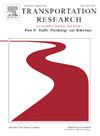Factors affecting driver speeding behavior in Mumbai school zones
IF 3.5
2区 工程技术
Q1 PSYCHOLOGY, APPLIED
Transportation Research Part F-Traffic Psychology and Behaviour
Pub Date : 2025-02-01
DOI:10.1016/j.trf.2024.12.029
引用次数: 0
Abstract
Reckless driving, especially speeding, is a dangerous behavior associated with fatalities, particularly among school children, and it greatly contributes to deadly accidents in school zones. Therefore, it is crucial to comprehend the elements that encourage speeding in these sensitive areas. This study examined how driver, vehicle, and roadway characteristics, as well as land-use patterns, influence speeding behavior in school zones by assessing the spot speeds of 7,197 vehicles from 11 school zones in Mumbai, India. These zones were chosen through zone-weighted cluster random sampling from a total of 4,150 school records. Results showed that 28.64% of vehicles surpassed the designated speed limits of 30 km/h. The analysis using a random intercept binary logistic regression model identified several factors affecting speeding behavior. Male drivers were 7.6% more likely to speed than female drivers. The location of the school influenced speeding, with probability 36.2% higher in unsignalized mid-blocks compared to signalized mid-blocks. Motorcycle drivers had the highest probability of speeding (11.8%), followed by SUVs (9.7%) and minivans (5.8%). Road environment characteristics also affected speeding. Wider roads were associated with increased speeding, while wider parking lanes led to a substantial decrease in speeding behaviors. These results provide urban planners and road safety programs with crucial insights. Addressing these factors can create safer school zones and protect children.
求助全文
约1分钟内获得全文
求助全文
来源期刊
CiteScore
7.60
自引率
14.60%
发文量
239
审稿时长
71 days
期刊介绍:
Transportation Research Part F: Traffic Psychology and Behaviour focuses on the behavioural and psychological aspects of traffic and transport. The aim of the journal is to enhance theory development, improve the quality of empirical studies and to stimulate the application of research findings in practice. TRF provides a focus and a means of communication for the considerable amount of research activities that are now being carried out in this field. The journal provides a forum for transportation researchers, psychologists, ergonomists, engineers and policy-makers with an interest in traffic and transport psychology.

 求助内容:
求助内容: 应助结果提醒方式:
应助结果提醒方式:


